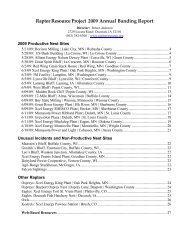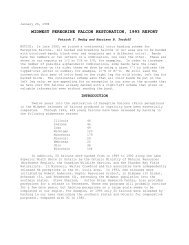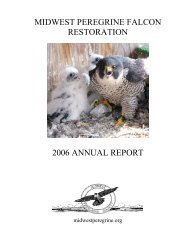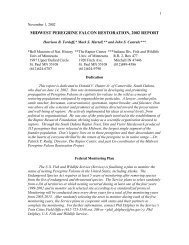cover photo - Midwest Peregrine Falcon Restoration Project
cover photo - Midwest Peregrine Falcon Restoration Project
cover photo - Midwest Peregrine Falcon Restoration Project
You also want an ePaper? Increase the reach of your titles
YUMPU automatically turns print PDFs into web optimized ePapers that Google loves.
Younger at the Multifoods site (see site #4). On March 20, Fallon observed Mendota on<br />
territory at this site, looking no worse for the wear after the territorial battle at Multifoods<br />
Tower the previous day. That same day, Fallon identified the new adult male, which turned<br />
out to be MPR2 b/g D/32, who had been at site #7 for the previous month. The pair laid three<br />
eggs; all hatched and fledged, two males and a female. Mendota hatched in 1997 at the<br />
Mendota Bridge in Fort Snelling State Park and MPR2 hatched in 2004 at the Multifoods<br />
Tower in Minneapolis, MN. As noted above, he had previously spent several weeks at the<br />
Lock and Dam #1 site.<br />
First year nesting attempted: 1997 Total young produced: 30<br />
9. SP-North Central Life Tower (currently called Bremer Tower), St. Paul, Ramsey County,<br />
Minnesota. For the third year, five-year-old Jill b/g 50/B, fledged in 2002 from a cliff at<br />
Castle Rock, Wisconsin was paired with thirteen-year-old Sota b/r 8/*E, fledged in 1994<br />
from the Mayo Clinic, Rochester, MN. The pair laid four eggs, three hatched, two males and<br />
one female fledged in late June from the original box, installed in 1988. As noted in previous<br />
years, the male at this site has partially missing digits or stunted talons on two of the four<br />
toes on each foot. Even so, and despite his age and disability, he seems able to provide food<br />
for his mate and young.<br />
First year nesting attempted: 1988 Total young produced: 49<br />
10. SP-North Star Bridge, Highway 169, Mankato, Blue Earth County, Minnesota. New Site. In<br />
December 2006, it was reported to Jackie Fallon by a reliable Mankato resident that a pair of<br />
peregrines had been on territory throughout the summer. However, it was recently reported to<br />
Fallon that the pair present in 2006 produced at least 2 young that were observed in October<br />
of that season. This season, Fallon observed a pair of peregrines on territory at the Highway<br />
169 Bridge over the Minnesota River that separates North Mankato and Mankato. Threeyear-old<br />
female Betsy b/g 31/D, 2004 fledge from NSP Prairie Island, MN and an unbanded<br />
adult male nested on the northern tier of the bridge, center of the deck. Four eggs were laid<br />
and three young males hatched and were banded on June 18. A 40’ ladder was used to reach<br />
the site. The three young fledged successfully and were closely monitored by Mankato<br />
resident Merrill Frydendall and DOT staff Larry Cooper and his bridge staff through the<br />
summer months. Dr. Luis Cruz and Karla Anderson scaled the ladder to reach the nesting<br />
ledge for banding.<br />
First year nesting attempted: 2006 Total young produced: 5<br />
11. SP-Mayo Clinic, Rochester, Olmsted County, Minnesota. Tom Behrens report that a pair of<br />
peregrines nested successfully here for the third year, after seven unproductive years between<br />
1997-2004. An unbanded adult male and an unbanded adult female produced four eggs and<br />
fledged four young, two males and two females. One of the female chicks was found in July<br />
with a severe case of trichimoniasis and was euthanized. As in the past, the entire banding<br />
process was televised throughout the clinic. The pair and young were videoed through the<br />
season for patients, visitors and staff to view in the lobby of the clinic, offering all a unique<br />
9








